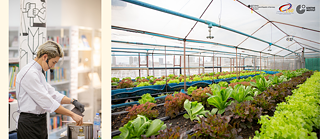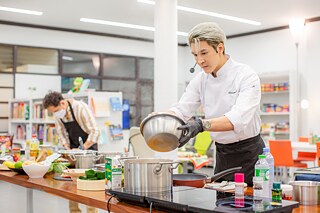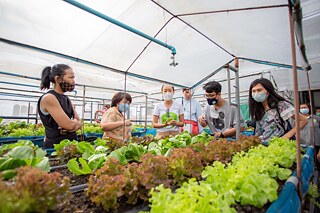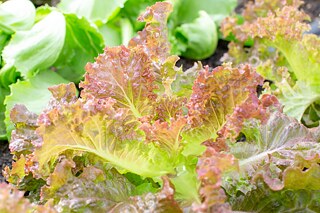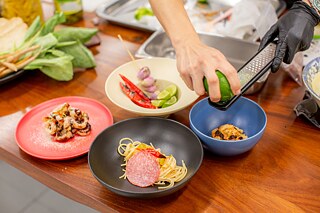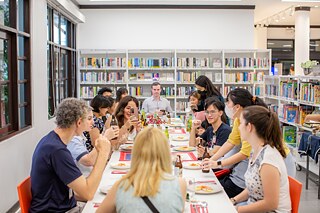By Wischapas Pimm-achsorn
According to FAO estimations, approximately one-third of all food produced in the world for human consumption, which is around 1.3 billion tons, is lost or wasted each year. Wasting food means wasting all the energy, water, and other resources it takes to grow, harvest, transport, and package it. And when food goes to the landfill and rots, it produces methane–a greenhouse gas that has more than 80 times the warming power of carbon dioxide. About 6%-8% of all human-caused greenhouse gasses emitted from food waste. In Thailand, 64% of total waste is food waste and one person creates 254 kilograms of food waste per year.
Surplus food turned into tasty goodness by Chef Boom
| © Goethe-Institut Thailand / Photos: Supachai Saingam
14 participants and the staff were divided into two groups, traveling by tuk-tuk to visit Baanrim Rooftop Farm, an organic vegetable farm built on the open roof decks of a Sathorn apartment building. Two decks and a mezzanine floor, totalling about 400 square meters, are used for growing seven types of lettuce and other winter vegetables such as kale, radishes, Swiss chard, etc., with soil on raised vegetable plots. Pesticides and chemical fertilizers are not used here. Pests are prevented in more environmentally friendly ways, by using bird wire screens, by planting vegetables of different colours one after another and by growing foreign varieties, which are less affected by pests than local varieties. Self-made bioextracts, which are used as fertilizers and for treating fungal diseases, are fermented from mixed fruits, fishes, and banana rhizomes. Khun Vee told us that this farm was originally her aunt’s project to experiment with organic vegetable farming on the rooftop as an activity after retirement, with support from Khun Vee’s father, who runs a construction business. But since her aunt passed away, her nieces and nephews continued the farm and fulfilled her dream.
Veerawan Katanyuvivad, owner of Baanrim Rooftop Farm, giving insights into organic farming
| © Goethe-Institut Thailand / Photos: Supachai Saingam
Baanrim Rooftop Farm started seven years ago and has been selling vegetables for five years, despite major obstacles such as heat, strong winds and mould that hit the farm. Today, Baanrim Rooftop Farm produces vegetables year-round. Orders can be placed via the LINE App and delivery areas are Sathorn’s neighbouring districts. You could tell that these organic vegetables are grown with care in every step: the harvested vegetables are appealing without trimming. Vegetable roots left in the soil after harvesting are collected and composted for the next round of planting.
Lettuce grown without using any chemicals or pesticides
| © Goethe-Institut Thailand / Photos: Supachai Saingam
After visiting the farm, the groups returned to the library to join the cooking show with Chef Boom. The ingredients provided by the participants included raw soybeans and peanuts, fresh chilies and limes, sugar, salt, brown rice, Chinese kale, spaghetti and penne, salami, whole wheat bread, cocoa powder, dark chocolate, crispy pork rinds, mirin, cottage cheese, honey, fried shallots, and pickled cucumber. With all these ingredients, Chef Boom created an alternative menu and named it "Khao Soi Goethe". He used spaghetti and penne instead of Khao Soi noodles, and prepared Khao Soi soup using curry paste with curry powder, Northern-Thai-styled roasted chilies, shallots, and garlics in pandan leaves, and roasted brown rice. Dark chocolate was used to darken the soup instead of dark soy sauce, and honey was used instead of coconut sugar. Topped with deep-fried spaghetti and lime zest, “Khao Soi Goethe" was served with salami, bread, lime, shallots, and pickled cucumber instead of pickled mustard greens. The soup was followed by another dish made from baked soybean and peanut sheet, topped with chili paste and fried shallots, and garnished with crispy pork rinds coated with the sauce made from nama, mirin and dark chocolate and frosted with cocoa powder and icing sugar.
Cooking show by Chef Boom in Goethe-Institut’s library: Kao Soi, crispy pork rinds coated with dark chocolate and mirin sauce and baked peanut sheet
| © Goethe-Institut Thailand / Photos: Supachai Saingam
During the show, Chef Boom shared several techniques of how to choose ingredients and manage food: from selecting the type of salt and chili to suit the food and preferences, to sugar caramelizing and proper chocolate melting (to use as a condiment in other dishes), and food designing and presenting in an aesthetic and appetizing way that appeals to all senses: appearance, smell, taste, and texture.
Participants enjoying the meal as the library turned into a creative meeting place
| © Goethe-Institut Thailand / Photos: Supachai Saingam
